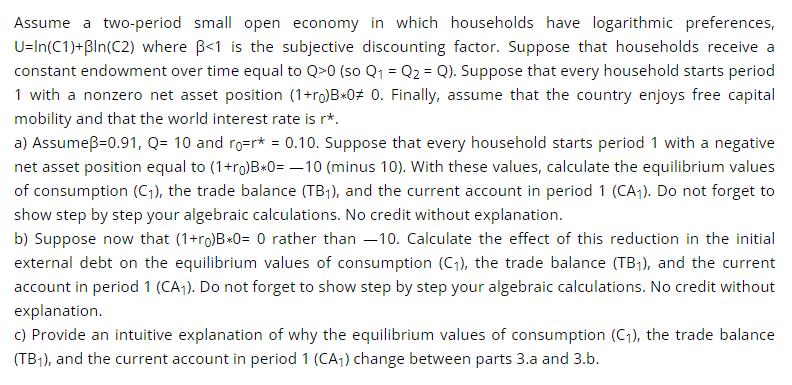Answered step by step
Verified Expert Solution
Question
1 Approved Answer
Assume a two-period small open economy in which households have logarithmic preferences, U=In(C1)+Bln(C2) where B <1 is the subjective discounting factor. Suppose that households

Assume a two-period small open economy in which households have logarithmic preferences, U=In(C1)+Bln(C2) where B 0 (so Q = Q2 = Q). Suppose that every household starts period 1 with a nonzero net asset position (1+ro)B*0# 0. Finally, assume that the country enjoys free capital mobility and that the world interest rate is r*. a) Assume=0.91, Q= 10 and ro-r* = 0.10. Suppose that every household starts period 1 with a negative net asset position equal to (1+ro)B*0=10 (minus 10). With these values, calculate the equilibrium values of consumption (C), the trade balance (TB), and the current account in period 1 (CA). Do not forget to show step by step your algebraic calculations. No credit without explanation. b) Suppose now that (1+ro)B*0= 0 rather than 10. Calculate the effect of this reduction in the initial external debt on the equilibrium values of consumption (C), the trade balance (TB), and the current account in period 1 (CA). Do not forget to show step by step your algebraic calculations. No credit without explanation. c) Provide an intuitive explanation of why the equilibrium values of consumption (C), the trade balance (TB), and the current account in period 1 (CA) change between parts 3.a and 3.b.
Step by Step Solution
★★★★★
3.51 Rating (154 Votes )
There are 3 Steps involved in it
Step: 1
a Assume091 Q 10 and r0r 010 Suppose that every household starts period 1 with a negative net asset position equal to 1r010 minus 10 With these values calculate the equilibrium values of consumption C ...
Get Instant Access to Expert-Tailored Solutions
See step-by-step solutions with expert insights and AI powered tools for academic success
Step: 2

Step: 3

Ace Your Homework with AI
Get the answers you need in no time with our AI-driven, step-by-step assistance
Get Started


